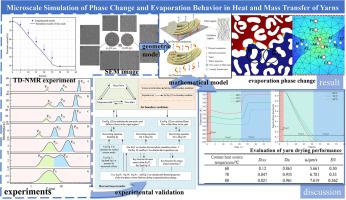Microscale simulation of phase change and evaporation behavior in heat and mass transfer of yarns
IF 5.8
2区 工程技术
Q1 ENGINEERING, MECHANICAL
International Journal of Heat and Mass Transfer
Pub Date : 2025-10-18
DOI:10.1016/j.ijheatmasstransfer.2025.127963
引用次数: 0
Abstract
The heat and mass transfer characteristics during textile drying are critical factors affecting fabric quality and energy efficiency. To explore the microscopic mechanisms at the yarn scale, this study utilizes realistic cross-sectional morphology data of yarn obtained by scanning electron microscopy (SEM) to develop a microscale coupled heat-moisture-flow drying model for yarn. The model simulates the microscale evaporation and phase change dynamics inside the yarn during drying. It reveals the synergistic effects of fiber arrangement, pore distribution, and drying process parameters. It quantitatively analyzes the influence of temperature gradient, fiber volume fraction, fiber wettability and heat source type on the evaporation process. The results show a strong positive correlation between heat source temperature and drying efficiency. The evaporation front rate at 80 °C under contact drying is 34.59 % higher than at 60 °C. Fiber volume fraction exhibits a dual effect: although it improves thermal conductivity, the reduced porosity restricts moisture transport and evaporation, which decreases overall drying efficiency. Compared with hydrophilic fibers, hydrophobic fibers dry 14.89 % faster. Dual-heat-supply drying enhances the synergy between mass and heat transfer inside the yarn, resulting in 8.33 % and 14.44 % increase in internal drying rate compared to contact drying and double convection drying. Compared with time-domain nuclear magnetic resonance (TD-NMR) measurements. For contact and dual-heat-supply drying, this study’s microscale coupled heat-moisture-flow drying model shows relative moisture deviations of 6.62 % and 5.93 %. The R² values are 0.984 and 0.989, respectively. This confirms the model's reliability and accuracy.

纱线传热传质过程中相变与蒸发行为的微观模拟
纺织品干燥过程中的传热传质特性是影响织物质量和能效的重要因素。为了探索纱线尺度上的微观机理,本研究利用扫描电子显微镜(SEM)获得的纱线真实横截面形貌数据,建立了纱线的微尺度热-湿-流耦合干燥模型。该模型模拟了干燥过程中纱线内部的微尺度蒸发和相变动力学。它揭示了纤维排列、孔隙分布和干燥工艺参数的协同作用。定量分析了温度梯度、纤维体积分数、纤维润湿性和热源类型对蒸发过程的影响。结果表明,热源温度与干燥效率呈显著正相关。接触干燥条件下,80℃的蒸发锋率比60℃高34.59%。纤维体积分数表现出双重作用:虽然它提高了导热性,但孔隙率的降低限制了水分的输送和蒸发,从而降低了整体干燥效率。与亲水性纤维相比,疏水性纤维干燥速度快14.89%。双热干燥增强了纱线内部传质和传热的协同作用,使纱线内部干燥率比接触干燥和双对流干燥分别提高8.33%和14.44%。与时域核磁共振(TD-NMR)测量结果进行比较。对于接触式双热干燥,本研究建立的微尺度热-湿-流耦合干燥模型的相对湿度偏差分别为6.62%和5.93%。R²值分别为0.984和0.989。这证实了模型的可靠性和准确性。
本文章由计算机程序翻译,如有差异,请以英文原文为准。
求助全文
约1分钟内获得全文
求助全文
来源期刊
CiteScore
10.30
自引率
13.50%
发文量
1319
审稿时长
41 days
期刊介绍:
International Journal of Heat and Mass Transfer is the vehicle for the exchange of basic ideas in heat and mass transfer between research workers and engineers throughout the world. It focuses on both analytical and experimental research, with an emphasis on contributions which increase the basic understanding of transfer processes and their application to engineering problems.
Topics include:
-New methods of measuring and/or correlating transport-property data
-Energy engineering
-Environmental applications of heat and/or mass transfer

 求助内容:
求助内容: 应助结果提醒方式:
应助结果提醒方式:


